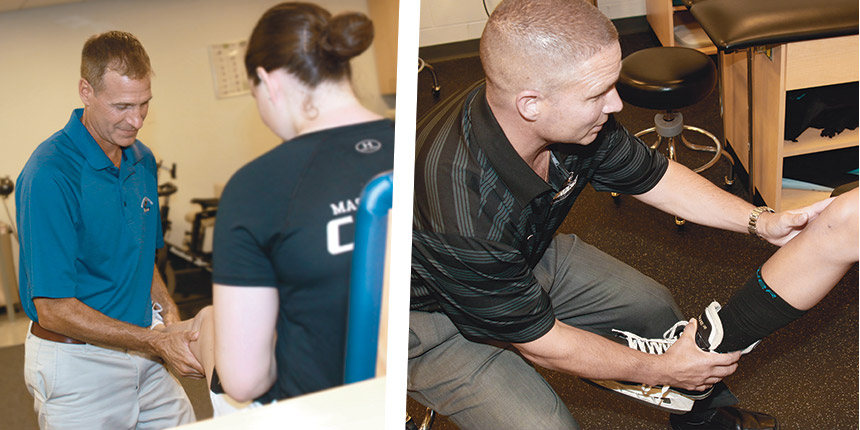Health+
Helping Student Athletes Prevent Sports Injuries

When injuries do occur, Southcoast orthopedic specialists can provide the best treatment options
Whether it’s in a gym or out on a field, participating in sports offers important lessons to young people, including how to work as a team, the value of competition and the joys of physical activity. The downside is the risk for injury. Fortunately, orthopedic specialists at Southcoast have the expertise to help student athletes and parents reduce that risk — or if injury does occur, they are ready to provide the best treatment options.
Matthew Baltz, MD, an orthopedic surgeon for Southcoast, has treated his fair share of young athletes from elementary, middle and high school. “It’s extremely common to see injuries among students in those age groups,” he says, describing fractures, as well as twists and sprains to knees, shoulders, ankles and wrists.
In addition to these sudden traumas, orthopedic physicians are treating more overuse injuries in young athletes. These tend to affect the joints and the connective tissues as a result of repeated stresses, such as those endured by a pitcher’s throwing arm, a tennis player’s elbow or a runner’s knees.
Why it’s important
Of course, everyone wants to avoid the pain and missed playing time associated with injury, but with young athletes there are also concerns for their long-term health. Young bones (up to age 15 or 16) have growth plates near their ends that facilitate laying down new bone until a person reaches his or her full height. Joseph Lifrak, MD, an orthopedic surgeon with Southcoast who also treats young athletes, says that some overuse injuries are leading to irritated growth plates. “The student can be out of commission for six to eight weeks,” he says.
In addition, says Dr. Baltz, “We might see problems down the line. Multiple injuries, especially those requiring surgery, such as an ACL tear at a very young age, may cause those patients to lose cartilage. The goal of surgical reconstruction is to get the student back to play, but no surgeon can restore 100 percent of the damage, and chance of re-injury is much higher.”
Dr. Baltz has seen people who had multiple knee injuries in their youth come back to see him in their 20s or 30s with early-onset arthritis. At that point, he says, “We may have to go with synthetic synovial fluid injections, or partial and even complete knee replacement, just for that person to be able to participate in activities of daily living, much less athletic participation.”
Preventive strategies work
No one can avoid all impacts and falls in sports. Dr. Lifrak and Dr. Baltz agree that proper conditioning and preparation can help reduce the severity of certain kinds of injuries. Here is a brief rundown of steps that can help young athletes and their parents:
- Have a preseason physical. Follow any recommendations given by the healthcare provider, especially in cases of previous injury.
- Warm up properly. Get blood flowing to muscles and stretch ligaments and tendons. This also applies to preseason training — remind the body about your sport before going in full-tilt.
- Drink plenty of water. Proper hydration before, during and after activity can help prevent cramping and headaches. Don’t wait until you’re thirsty.
- Wear protective gear. Pads, shin guards, helmets and gloves should fit well and be in good repair.
- Mix it up. Playing different sports or different positions over the course of a year helps limit muscle imbalance and stress on the same joints. Also, be cautious if sports seasons overlap; do not overdo it.
Even though schools, families and teammates have invested time, heart and soul into their chosen sports, it’s not good for youngsters to play with pain. Dr. Baltz says that it is important for student athletes, parents and coaches to respect the balance between sports goals and the need for a healthy body.
To learn more about treating sport insuries, visit Southcoast Health Orthopedics.
